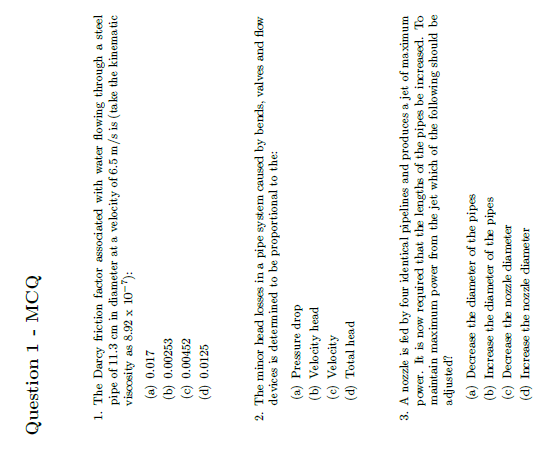1. The Darcy friction factor associated with water flowing through a steel pipe of 11.3 cm in diameter at a velocity of 6.5 m/s is (take the kinematic viscosity as 8.92 x 10-7): (a) 0.017 (b) 0.00253 (c) 0.00452 (d) 0.0125
1. The Darcy friction factor associated with water flowing through a steel pipe of 11.3 cm in diameter at a velocity of 6.5 m/s is (take the kinematic viscosity as 8.92 x 10-7): (a) 0.017 (b) 0.00253 (c) 0.00452 (d) 0.0125
Elements Of Electromagnetics
7th Edition
ISBN:9780190698614
Author:Sadiku, Matthew N. O.
Publisher:Sadiku, Matthew N. O.
ChapterMA: Math Assessment
Section: Chapter Questions
Problem 1.1MA
Related questions
Question
Kindly answer correctly. . Thank you so much

Transcribed Image Text:Question 1 MCQ
1. The Darcy friction factor associated with water flowing through a steel
pipe of 11.3 cm in diameter at a velocity of 6.5 m/s is (take the kinematic
viscosity as 8.92 x 10-7):
(a) 0.017
(b) 0.00253
(c) 0.00452
(d) 0.0125
2. The minor head losses in a pipe system caused by bends, valves and flow
devices is determined to be proportional to the:
(a) Pressure drop
(b) Velocity head
(c) Velocity
(d) Total head
3. A nozzle is fed by four identical pipelines and produces a jet of maximum
power. It is now required that the lengths of the pipes be increased. To
maintain maximum power from the jet which of the following should be
adjusted?
(a) Decrease the diameter of the pipes
(b) Increase the diameter of the pipes
(c) Decrease the nozzle diameter
(d) Increase the nozzle diameter
Expert Solution
This question has been solved!
Explore an expertly crafted, step-by-step solution for a thorough understanding of key concepts.
Step by step
Solved in 3 steps with 7 images

Knowledge Booster
Learn more about
Need a deep-dive on the concept behind this application? Look no further. Learn more about this topic, mechanical-engineering and related others by exploring similar questions and additional content below.Recommended textbooks for you

Elements Of Electromagnetics
Mechanical Engineering
ISBN:
9780190698614
Author:
Sadiku, Matthew N. O.
Publisher:
Oxford University Press

Mechanics of Materials (10th Edition)
Mechanical Engineering
ISBN:
9780134319650
Author:
Russell C. Hibbeler
Publisher:
PEARSON

Thermodynamics: An Engineering Approach
Mechanical Engineering
ISBN:
9781259822674
Author:
Yunus A. Cengel Dr., Michael A. Boles
Publisher:
McGraw-Hill Education

Elements Of Electromagnetics
Mechanical Engineering
ISBN:
9780190698614
Author:
Sadiku, Matthew N. O.
Publisher:
Oxford University Press

Mechanics of Materials (10th Edition)
Mechanical Engineering
ISBN:
9780134319650
Author:
Russell C. Hibbeler
Publisher:
PEARSON

Thermodynamics: An Engineering Approach
Mechanical Engineering
ISBN:
9781259822674
Author:
Yunus A. Cengel Dr., Michael A. Boles
Publisher:
McGraw-Hill Education

Control Systems Engineering
Mechanical Engineering
ISBN:
9781118170519
Author:
Norman S. Nise
Publisher:
WILEY

Mechanics of Materials (MindTap Course List)
Mechanical Engineering
ISBN:
9781337093347
Author:
Barry J. Goodno, James M. Gere
Publisher:
Cengage Learning

Engineering Mechanics: Statics
Mechanical Engineering
ISBN:
9781118807330
Author:
James L. Meriam, L. G. Kraige, J. N. Bolton
Publisher:
WILEY